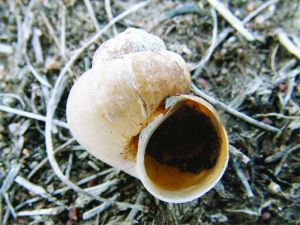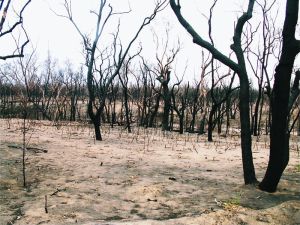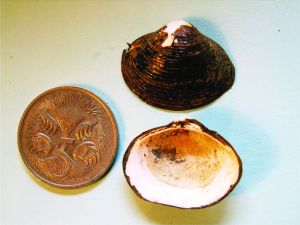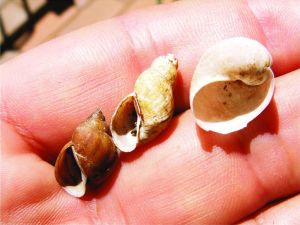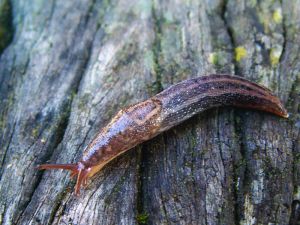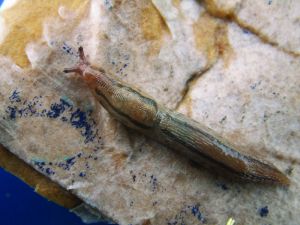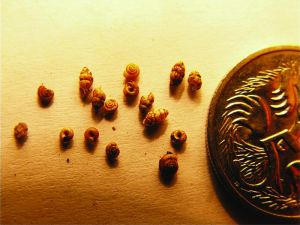|
The Pilliga Scrub (30° 45’ S, 149° 15’ E) is a vast 450,000 hectare (1.1 million acre) area of semi-arid eucalypt and cypress pine woodland in Gamilaraay Aboriginal Country in inland northern New South Wales, Australia. The landform ranges from low sandstone ridges and hills separated by wide sandy valleys in the east to an extensive flat outwash sand plain in the west and north. The Pilliga is a harsh environment for molluscs. The sandy soils are poor in nutrients. Rainfall is infrequent and irregular and streams are dry for most of the year. Summers are hot (often up to 45° C), with frequent intense bushfires initiated by dry thunderstorms. A field survey of aquatic and terrestrial molluscs in a 9,674 km2 (3735 sq mile) study area, comprising the entire Pilliga Scrub as well as farmland, towns and villages in the local area, was started in 2006 and is ongoing. To help readers appreciate the scale of this study area, it is larger than North Yorkshire or the combined area of Norfolk and Suffolk in England, larger than the combined area of Powys, Ceredigion and Carmarthenshire in Cymru (Wales) and larger than the combined area of County Cork and County Waterford in Eire (Ireland). Very little work on the molluscs of the Pilliga had been done prior to this survey. Molluscs have been sampled at 253 sites across the study area to date, sampling the range of habitats present. Survey methods for land snails and slugs involved hand searches of leaf litter, turning fallen timber and other ground debris, collection of leaf litter and soil samples for searching under magnification, and occasional searches with a torch on wet nights looking for active animals. Some snails were also found during fire-fighting work, when the ground litter was completely burned away. Survey methods for aquatic species primarily involved searching along the dry beds of streams and lagoons (including under debris), and occasional searching along the margins of water bodies. The mollusc fauna of the Pilliga was found to be richer than expected for such a harsh, dry area. Four bivalve species (two families), 10 species of freshwater snail (six families) and 23 species of land snail and slug (11 families) have been recorded so far (see Table 1). The greatest contributors to this diversity are the Hyriidae (3 species), Planorbidae (4 species), Pupillidae (7 species) and Camaenidae (4 species). Records of particular interest include the following:
The survey so far has revealed differences between the mollusc assemblages of the rugged sandstone country of the east Pilliga and the outwash sand plain of the west/north Pilliga (see Table 1). The slow-moving streams of the outwash plain appear to support a far greater diversity of aquatic molluscs than the faster-flowing streams in the east. Only two (out of 14) aquatic species have been recorded in both areas. There was considerably more overlap (or less difference) amongst the native land snail assemblages of the two areas, with 10 (out of 16) species recorded in both. It remains to be seen whether these patterns are supported by continued sampling. The mollusc fauna of the Pilliga (and Australia in general) comprises three different elements (Smith and Kershaw 1979). Families such as the Hyriidae, Charopidae and Rhytididae are part of an ancient Gondwanan group which predates the break-up of Australia, Africa and South America and is probably over 100 million years old. A second group, which includes the Camaenidae, only reached Australia from south-east Asia within the last 15 million years. Lastly, families such as the Physidae, Bradybaenidae, Limacidae, Helicidae and Zonitidae represent a modern element dating from the last 200 years and comprising ecologically catholic tramp species originating from Europe, eastern Asia and North America. Much work remains to be done before Australia is able to produce a publication comparable to Kerney (1999), with detailed record-based distribution maps for all freshwater and terrestrial mollusc species at a national scale. An estimated two thirds of Australia’s land snail fauna has yet to be formally described (Stanisic and Ponder 2004) and many parts of the continent have only been poorly sampled or not sampled at all. The present study demonstrates the unexpected diversity which can be found in an area previously only poorly sampled. Acknowledgements My children Jess, Nicola and Sam helped with field work. Michael Shea (Australian Museum) and John Stanisic (Queensland Museum) helped with species identification and Michael Shea also provided comments on a draft of this paper. References Jones, H.A., 2007. The influence of hydrology on freshwater mussel (Bivalvia: Hyriidae) distributions in a semi-arid river system, the Barwon-Darling River and intersecting streams. Pp. 132-142 in Animals of Arid Australia: out on their own?, edited by C. Dickman, D. Lunney and S. Burgin. Royal Zoological Society of New South Wales, Mosman, NSW, Australia. Kerney, M., 1999. Atlas of the Land and Freshwater Molluscs of Britain and Ireland. Harley Books, Colchester, England. Ponder, W.F., Clark, S.A. and Dallwitz, M.J., 2000. Freshwater and Estuarine Molluscs: An Interactive, Illustrated Key for New South Wales. CD ROM, CSIRO Publishing, Australia. Ponder, W.F. and Walker, K.F., 2003. From mound springs to mighty rivers: The conservation status of freshwater molluscs in Australia. Aquatic Ecosystem Health & Management 6(1): 19-28. Smith B.J. and Kershaw R.C., 1979 Field Guide to the Non-Marine Molluscs of South Eastern Australia. Australian National University Press: Canberra, Australia. Stanisic, J. and Ponder, W.F., 2004. Forest snails in eastern Australia – one aspect of the other 99%. Pp. 127-149 in Conservation of Australia’s Forest Fauna (2nd edition), edited by D. Lunney. Royal Zoological Society of New South Wales: Mosman, NSW, Australia. |
Figure 1: Velesunio ambiguus, the most common mussel species found in the Pilliga, can survive buried in the moist sand below dry stream beds for up to 2 years.
Figure 2: Notopala sp. is the largest native gastropod in the Pilliga and was found in slow-moving streams which are dry for most of the year.
Figure 3: Austrorhytida sp. A is an undescribed species of carnivorous snail from the nearby Warrumbungle Ranges which was found in the Pilliga in both native woodland and in urban waste ground.
Figure 4: Aftermath of an extreme intensity bushfire in the eastern Pilliga in 2006. All ground litter, ground vegetation and shrubs were incinerated, tree trunks were charred to 15 metres (49 feet) or higher and all canopy foliage scorched.
Figure 5: Streams in the Pilliga are dry for most of the year, although water can usually be found under the sand.
Figure 6: Corbicula australis was only found in fast flowing sandy streams in the eastern Pilliga. The Australian 5 cent coin is about the size of a UK 5p coin or a 2 Euro cent coin.
Figure 7: Two different shell shapes of the planorbid Glytophysa gibbosa (left and centre) with the lymnaeid Austropeplea lesson (right) collected from a dry stream in the west Pilliga.
Figure 8: The camaenid Neveritis aridorum is a widespread species in the Pilliga Scrub.
Figure 9: The introduced slug Lehmannia nyctelia is common in the study area in gardens and urban waste ground.
Figure 10: The introduced slug Limax maximus is rare in the study area in urban gardens and waste ground.
Figure 11: Many land snails found in the Pilliga are very small. The punctid and pupillid shells shown here are dwarfed by an Australian 5 cent coin. |
A field survey of the molluscs of the Pilliga Scrub in semi-arid inland New South Wales, Australia
Issue
19
Page
18


